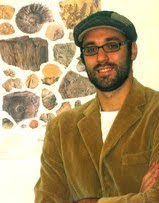Today I met the interesting expression "Human Geology" and I questioned myself about its meaning:
1) human geology could be the set of human processes resembling sedimentation. In a certain sense, cities are "human geologies".
2) "human geology" could also refer to the structured organization of the mind. In other words, "human geology" is the geology inside, as expressed by the intricate structure of human mind (and brain).
Art gave me clearer answers. The second meaning (human mind as a geologic space) is represented by David Reinstein, who invokes "a human geology" when citing the poem "Diamonds in the Rough". "Diamonds in the Rough" is a common metaphor for the original unpolished state of diamond gemstones, especially those that have the potential to become high quality jewels. Indeed it is an expression for indicating someone who is basically good hearted but lacking social graces and respect for the law.
1) human geology could be the set of human processes resembling sedimentation. In a certain sense, cities are "human geologies".
2) "human geology" could also refer to the structured organization of the mind. In other words, "human geology" is the geology inside, as expressed by the intricate structure of human mind (and brain).
Art gave me clearer answers. The second meaning (human mind as a geologic space) is represented by David Reinstein, who invokes "a human geology" when citing the poem "Diamonds in the Rough". "Diamonds in the Rough" is a common metaphor for the original unpolished state of diamond gemstones, especially those that have the potential to become high quality jewels. Indeed it is an expression for indicating someone who is basically good hearted but lacking social graces and respect for the law.
Diamonds in the Rough
Diamonds recline in unlikely places
While shoe soles and bare feet have no idea
Of treasure buried right beneath their steps.
Feet can't see. That takes eyes.
Rubies, emeralds, sapphires and plain quartz -
Small parts of larger wholes - buried in dark holes.
Sand is so much easier for me to see by the sea
Right where I would expect (and need) it to be.
We all see it readily because we know it is there,
Unhidden, glistening in the subtle minutia of grains-
To see it takes no brains.
What there is, is always there.
What we see is what we expect to see.
It takes the eyes of a scientist to see what is not expected
And the mind of a gemologist to find the diamonds
Embedded in the silt of our souls.
Sources of divine energy,
Criterion for the clergy or
Fuel for a liturgy.
And what about the first meaning? I could refer to "human geologies" when admiring the artwork of Blu. He metamorphosed urban landscapes in living paleoenvironments. Paleontology in Art?
These examples cleared up my ideas by showing the double-look of the expression "Human Geology":
1) Human spaces as geological places.
2) Human minds as geological places.
Are these meanings mutually exclusive? B.J. Vogt joined these apparently distant viewpoints and created "A Human Geology", which is explained by the artist himself as the distance between island topography and the structure of the human brain. Indeed these elements are morphologically similar, as explained by fractal geometry (coasts and brain are typical examples of fractals).
While shoe soles and bare feet have no idea
Of treasure buried right beneath their steps.
Feet can't see. That takes eyes.
Rubies, emeralds, sapphires and plain quartz -
Small parts of larger wholes - buried in dark holes.
Sand is so much easier for me to see by the sea
Right where I would expect (and need) it to be.
We all see it readily because we know it is there,
Unhidden, glistening in the subtle minutia of grains-
To see it takes no brains.
What there is, is always there.
What we see is what we expect to see.
It takes the eyes of a scientist to see what is not expected
And the mind of a gemologist to find the diamonds
Embedded in the silt of our souls.
Sources of divine energy,
Criterion for the clergy or
Fuel for a liturgy.
And what about the first meaning? I could refer to "human geologies" when admiring the artwork of Blu. He metamorphosed urban landscapes in living paleoenvironments. Paleontology in Art?
These examples cleared up my ideas by showing the double-look of the expression "Human Geology":
1) Human spaces as geological places.
2) Human minds as geological places.
Are these meanings mutually exclusive? B.J. Vogt joined these apparently distant viewpoints and created "A Human Geology", which is explained by the artist himself as the distance between island topography and the structure of the human brain. Indeed these elements are morphologically similar, as explained by fractal geometry (coasts and brain are typical examples of fractals).






No comments:
Post a Comment